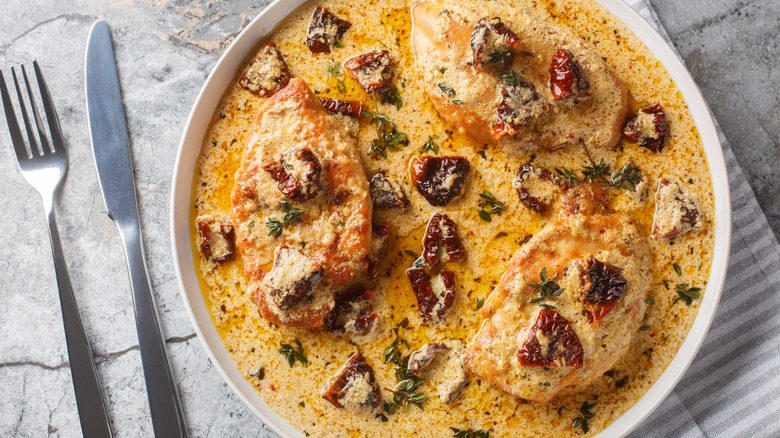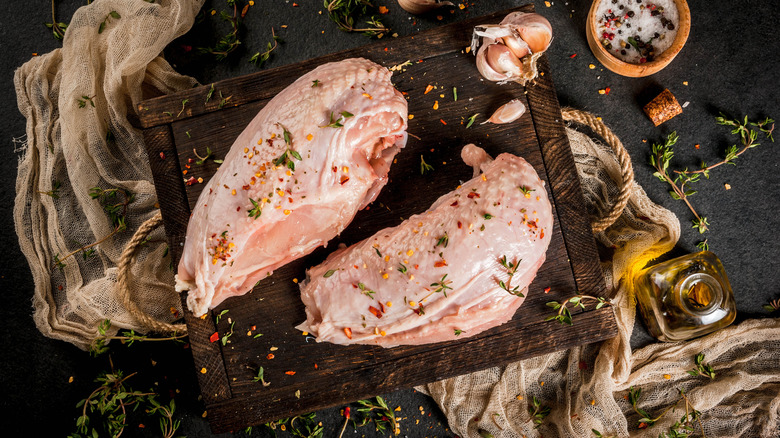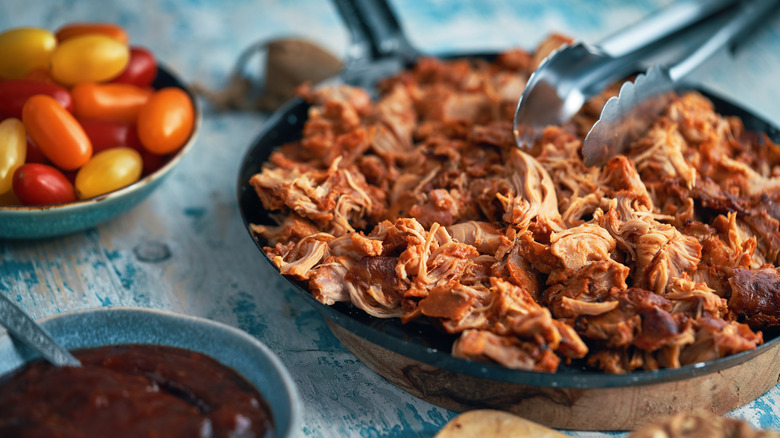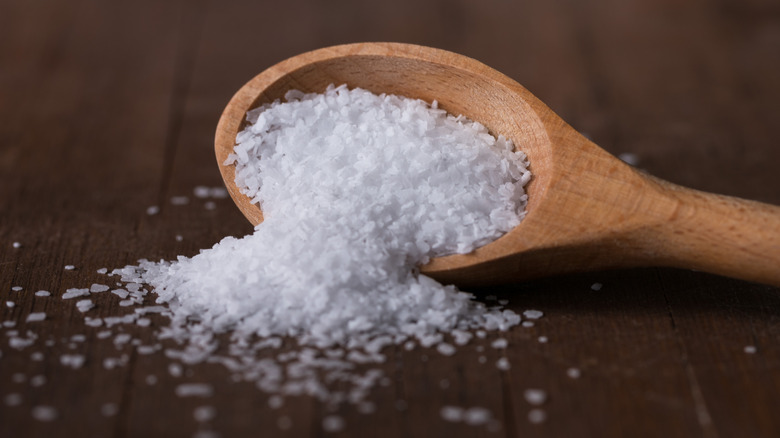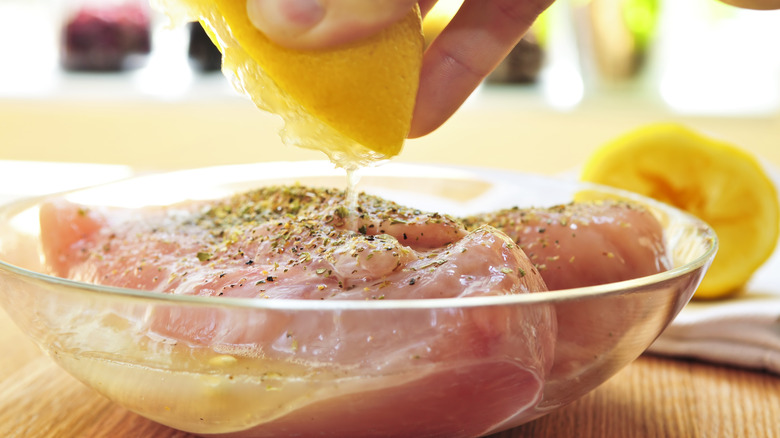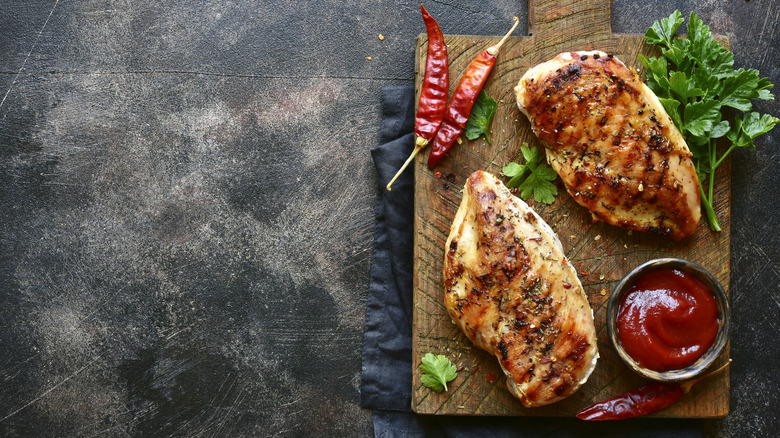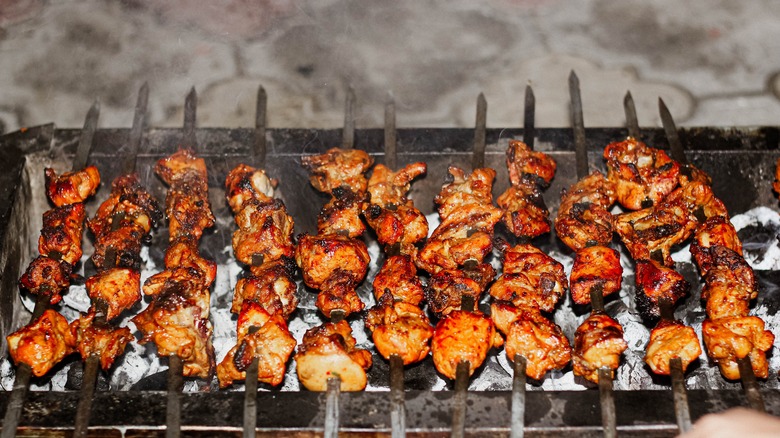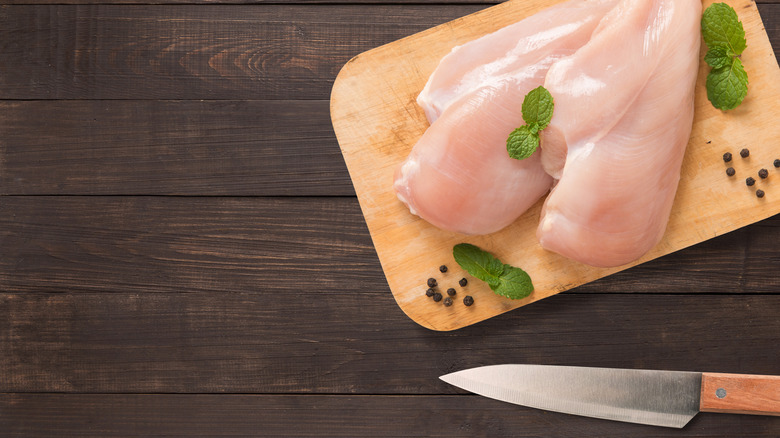8 Ways To Upgrade The Flavor Of Chicken Breast
Chicken breast is a go-to protein for many of us. It's one of the leanest meats, it's easy to find at any grocery store, it's more affordable than many other proteins, and it will usually satisfy the pickiest eaters among us. Chicken breast also has a mild flavor that takes on other flavors well and lends itself to many different dishes from a multitude of cuisines. However, sometimes chicken breast runs the risk of turning out pretty darn bland — or worse, dry as a bone and tough as a brick. But it doesn't have to be that way! There are several simple techniques that will help you get the most out of everyone's favorite white meat.
We've all been served a tough and tasteless chicken breast at a wedding reception or on a flight and probably sighed to ourselves, "Well, at least I'm getting sustenance." But chicken breast can be so much more. Whether you're aiming for a simple chicken salad or a rich, roasted main for a dinner party, succulent and flavorful chicken is within reach, we promise. From choosing the right cut to a few prepping hacks and simple cooking techniques, here are some easy ways to upgrade your chicken breast that will help you achieve the perfect texture, and boost flavor to the max. No more boring chicken. Say hello to satisfying meals from now on.
Leave the skin on
Lots of people prefer boneless skinless chicken breasts because they seem easier to prepare, and have a reputation for being healthier. Sure, they're less fatty, but the problem is, they're also less flavorful. The bone and the fat in chicken skin is part of what keeps the bird tasty and moist. And the skin itself can be crispy and delicious when cooked right. If ultra lean eating isn't your primary goal, consider picking up some bone-in and/or skin-on chicken breasts next time you're at the butcher counter. Certainly, when you're serving a whole breast as a main course, these cuts will be much more flavorful and look great on the plate with crisped, seasoned skin.
Celebrity chef and cookbook author Ina Garten explains why she never removes the skin from chicken breasts. Leaving the skin on protects the meat from drying out in the pan or oven, and seals in more juices. Even if you choose not to eat the skin in the end, you can keep it on during the cooking process to get more flavor into the chicken meat and easily remove it before serving. But you can also fry that skin up to make chicken skin chips. As the skin fries in a pan or crisps up on a baking sheet, lots of the fat will render out, leaving a super salty and crunchy snack you can eat on its own or crumble and use as a topping for soups and salads.
Poach and pull chicken breast
If you're not aiming for crispy skin, cooking chicken breast in liquid can be the best approach. Poaching is a process of cooking slowly in liquid that isn't fully boiling; this keeps the meat tender while minimizing the amount of oil and fat. Poached or simmered chicken can be shredded easily and used in tons of recipes. Pulled chicken is excellent for tacos, nachos, and salads, as well as soups, stews, and chilis.
You can quickly sear the breast first or sauté some aromatics in the pan, then add cold broth or water to gently poach or simmer seasoned chicken breast until cooked through. Shred it up with two forks (or give this KitchenAid attachment a whirl). You can reduce the remaining liquid if it's flavorful enough and add that sauce into the pulled chicken for a moist and flavorful protein that's perfect for topping your favorite dishes. Cooking your chicken breast this way will stretch the value of that meat, too. Two breasts are enough for at least four servings.
You can do this on the stovetop with a pan that has a lid, or in the slow cooker for a slow-and-low cook that can go on all afternoon while you go about your day. Other recipes that cook chicken in liquid, like curries or this ginger chicken jook rice porridge, may not explicitly call for you to shred the meat, but they will also yield tender, flavorsome, and fall-apart chicken.
Dry or wet brine your chicken before cooking
There's a science to salting meat, and larger pieces of chicken can be salted earlier than you might think. Salt draws out moisture, so you want to give the meat time to reabsorb that moisture and salt, and take in that seasoning before you cook it. Properly seasoned meat will have way more flavor and be juicier than meat that is seasoned right before eating. Next time you pick up some chicken breasts, you can salt them as much as a whole day before. Just remove them from the packaging, pat dry, season with kosher salt, and pop them back into the fridge until you're ready to cook them. This process is sometimes called dry brining.
You can also try wet brining your chicken in a saltwater solution. This takes less time, but it's not a good option for water-chilled chicken. The simplest brine is just a solution of water and kosher salt, but you can add some spices or even give a pickle juice marinade a go next time you're making fried chicken. Place chicken pieces into the brine and let them sit for ½ hour to an hour. Salting ahead of time helps to greatly enhance the flavor of the meat. Just make sure to use the right amount of salt (a few teaspoons) — too much can be overpowering but not enough, and it won't get the job done — and remember that not all salts are equally salty.
Marinate chicken overnight
The best way to lock in flavor is to marinate chicken breast before you cook it. Brining will season the meat, but marinating will add loads of other flavors to your dish. Ingredients like herbs, spices, citrus, and olives will integrate more deeply into the meat in a marinade rather than simply adding them to the pan just before cooking. A few hours will do the trick in a pinch, but marinating overnight will yield the best results. You can marinate bone-in, skin-on chicken breasts before roasting or cut up pieces of chicken breast for stir-fries and skewers. Place the chicken into a bowl and cover, or place it in a sealed plastic bag to cover the most surface area of the meat. Then, leave it in the fridge and let it come to room temperature again before cooking the next day.
There is a lot of variety when it comes to marinades, and you'll find recipes from all different cultures and cuisines you can try. You can marinate chicken in yogurt or buttermilk to make it extra moist and tender. Many Indian dishes, like tandoori chicken, marinate meat in yogurt and spices. Or you can use an oil and vinegar marinade with some Italian spices. Mayo makes another good base for marinade when combined with other flavors like Dijon mustard. Soy, ginger, honey, and miso mixed with oil make for a delicious sticky, sweet baked chicken, and thighs will work as well as breasts.
Take it off the heat sooner
Another way to keep your chicken breast from drying out is to undercook it just a little at first. Yup, you read that right. Scared though we rightfully are of raw chicken and salmonella, we often tend to overcorrect. Chicken breasts, more so than thighs, end up overcooked and unpleasant to eat. Removing the chicken from your air fryer just a minute or two before it's reached the ideal internal temperature and tenting it on the counter will let the meat finish cooking from residual heat and ensure that it doesn't overcook. Therefore, it retains more of its juices. The USDA recommends different meats to be cooked to different internal temperatures for safe consumption, and chicken beast clocks in at 165 degrees Fahrenheit. You don't want to underdo it too much, but pull it off the heat around 160, and it will come to temperature on the counter with carry-over heat if you let it rest before serving.
Likewise, when preparing certain dishes, like stir-fries, you don't need to leave your chicken in the pan the whole time. Sear the chicken, then remove it from the heat while you sauté your onions and aromatics. Once you've got that flavor base ready, your curry sauce started, or your veggies softened a little, then add the chicken back in to finish cooking. That way, you don't dry out the meat while you wait for the rest of the dish to come together.
Pound it flat
Pounding or slicing chicken breast into thin cutlets is a great way to cut down cook time. You'll be able to fry them quickly without drying out the outside waiting for the center to cook. Plus, it will increase the surface area of the chicken that comes in contact with seasoning as well as the pan. You can buy cutlets pre-sliced or simply slice the breast into thin cutlets yourself. You can also pound chicken breast between parchment paper or plastic wrap with a mallet or meat tenderizer. Pounding the chicken will tenderize the meat more, and you can ensure even thickness, which helps the meat cook evenly. Of course, thinner cuts are also easier to overcook, but keep an eye on things, and you'll have a crisp and juicy cutlet that is sure to be a favorite with all members of your family.
Many flavorful classic dishes employ this technique. Chicken piccata cooks pounded chicken breast dredged in flour in a white wine, lemon, and caper sauce. Chicken schnitzel is a thin, fried breaded cutlet often served with potatoes and cranberry sauce. Both dishes are easier to make than you might think. Get creative with your cutlets. You can use panko for tasty chicken katsu or try this cornflake chicken Milanesa for an easy weeknight dinner. You can even put extra breaded chicken into a sandwich for lunch the next day. Just make sure to avoid this common mistake that leads to burnt chicken cutlets.
Grill chicken breast right
Grilled chicken is a summer favorite. The barbecue can be a great option for chicken breast, but you'll want to avoid this chicken grilling mistake: To seal in that smoky flavor and keep the meat's texture just right, close the lid after the initial sear. This will keep a more even heat. If you're making barbecue chicken with sauce, you'll also want to baste the chicken a few times while it cooks to keep it moist and flip the pieces for even cooking. After searing a chicken breast, move a thicker cut to the part of the grill with more indirect heat to continue cooking with the lid closed. That way, it will cook through to the center without burning the outside.
Smoky grilled chicken is delicious, and there are several tips for making the best grilled chicken. For one, don't throw cold meat right on the grill; it won't cook evenly. Let it come to room temp first. You can grill a whole chicken, breasts, or skewers. No matter how you slice it, brining or marinating the meat first will help a lot to keep it seasoned and juicy, and make sure to pat it dry before placing it over the flame, or it won't crisp up. A bonus tip for making kebabs is to soak wooden skewers in water on a shallow tray before adding the meat or veggies and grilling. This will help prevent the exposed wood from simply burning on the grill.
Prick the chicken breast first
Another super easy way to avoid bland chicken breast is to poke a few holes in it. Poking some holes in a chicken breast before cooking it helps the seasoning penetrate the meat better. You can do this by pricking it a few times with a fork or making a few small incisions with a small, sharp pairing knife. In doing this, you're creating more pathways for the seasoning to reach the meat quickly.
You don't want to slice all the way through the meat; just poke a few small holes into the flesh before adding your salt, spice rub, or marinade and see the difference it makes. Another tip is to lift the skin of chicken breast up and put salt underneath it. This allows the salt to reach the flesh more easily without having to pass through the fatty skin. You'll want to season the skin a little too though, to ensure that it crisps nicely.
